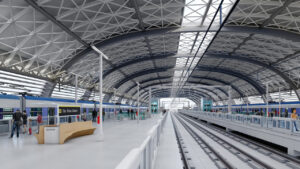THE active official development assistance (ODA) portfolio rose 6% to $39.6 billion in 2024, the Department of Economy, Planning, and Development (DEPDev) said.
In its ODA Portfolio Review Report, the DEPDev said ODA consists of 426 loans and grants, with infrastructure development driving the bulk of new commitments.
Overall, 111 loans supported 93 programs and projects of the government, it said.
“New loan commitments on infrastructure drove the increase, with nine of the 17 fresh loans worth $8.2 billion supporting the Marcos Administration’s Infrastructure Flagship Projects (IFPs),” it said.
Aside from the new loans, the portfolio includes 76 ongoing loans ($23.32 billion), 17 closed loans ($5.70 billion) and one cancelled loan ($4.48 billion).
Economy Undersecretary Joseph J. Capuno said the closed loans were mostly related to pandemic response and social protections while the cancelled one was for the Bureau of Customs Modernization Project.
“This is the highest total ODA amount recorded in a decade,” Mr. Capuno said at a briefing.
Some 62.7% of the portfolio involved transport and connectivity infrastructure.
The Japanese government remains the top development partner, with $13.23 billion in active commitments across 82 loans and grants.
It was followed by the Asian Development Bank ($11.05 billion), the World Bank ($8.64 billion), other sources ($2.96 billion), the Asian Infrastructure Investment Bank ($2.38 billion), and South Korea ($1.34 billion).
Among the recently completed projects were Phase III of the Arterial Road Bypass in Bulacan and the Panguil Bay Bridge in Lanao del Norte.
Mr. Capuno noted several recurring issues causing project implementation delays, including budget and fund flow problems, which affected 29 projects.
“Among the major concerns here include non-inclusion of some proposed projects in the 2024 GAA (General Appropriations Act), or their reclassification to unprogrammed allocations,” he said.
Site conditions and availability issues affected 26 projects. The issues include delays in land acquisition, right-of-way, and unresolved expropriation cases.
Procurement-related challenges affected 25 projects, including bid preparation delays, failed bids, and weak planning.
However, 43 projects were identified as “at-risk,” most of them being implemented by the Department of Public Works and Highways (DPWH) and the Department of Transportation (DoTr).
These include the Cebu Bus Rapid Transit Project, the Support to Parcelization of Lands for Individual Titling (SPLIT) Project, the Philippine Seismic Risk Reduction and Resilience Project and the Metro Manila Subway Project Phase I.
Mr. Capuno said ODA will continue to serve as the primary source of financing for government projects, even as the country gradually transitions to upper middle-income (UMIC) status.
“As we move toward UMIC classification, there is a grace period during which we can still access concessional loans from our development partners,” Mr. Capuno said, adding that the government will increasingly explore public-private partnerships. — Aubrey Rose A. Inosante
